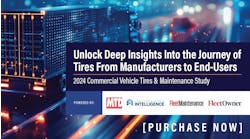Robotic workers are ready to take on some tough jobs, and they come bearing an unexpected gift.
Meet Oscar MK5. He's a brand new robot designed specifically by the French company Robosoft to fuel trucks and buses. Oscar MK5 offers many improvements over his predecessors, according to the manufacturer, including shorter cycle times, greater reliability and safety, the ability to handle liquefied propane gas (LPG) as well as gasoline and diesel, and lower cost.
When a vehicle pulls into the fueling lane and shuts down, Oscar goes to work.
Moving along his rail, Oscar reads an electronic tag on the vehicle to find the fuel tank filler cap and connects with it automatically, without overfilling or spilling, says Robosoft. The robot's modular design is intended to accommodate all types of filling nozzles and connectors. A computerized fuel ticketing system also enables him to keep exact fueling records for each vehicle.
Oscar systems are designed to have a service life of 10 years, assuming they work 24 hours a day, 7 days a week. The company estimates the payback period at 32 to 48 months. If your fleet does centralized fueling, Oscar might be an HR manager's dream for the fueling station attendant's job.
While Oscar is out there at the pumps, he might even do more to help your business. What if you merged Oscar's fueling capabilities with on-board computing and communications technologies, for instance? Then a robot could capture and transmit operational as well as transactional data from a vehicle-mounted RF tag. Things like bills of lading, manifests, signatures, or any of the other paperwork drivers get during a delivery or pickup could be transmitted right during fueling, along with any vehicle-specific data, such as engine fault codes. No human handling required.
Working robots may seem to be the stuff of science fiction, but commercial robots have been around since 1961, mostly laboring in factories anchored to the floor - and anchored to tasks humans find dangerous, difficult or just plain dull. Mobile and semi-mobile robots like Oscar, however, are out in the field working alongside people, and that opens up a whole new world of possibilities.
So what else besides fueling might mobile or semi-mobile robots do for your business? For starters, they might make good technical assistants. Robots can read bar codes to pick parts. They can also lift and move loads too heavy for people, and handle highly repetitive tasks, like mounting tires or even scrubbing the shop floor.
Scientists and engineers are also experimenting with robots that can cooperate not only with humans but with one another to accomplish complex tasks. According to The Futurist (August-September 1998), a team of British engineers at Salford University recently built a pair of robots, dubbed Fred and Ginger, that demonstrated their ability to move an object together and avoid obstacles along the way.
Think in terms of a partnership when you're considering new applications for robotics, advises Joseph Engelberger, the American who developed the first commercial robot. "The smarts are coming from the human, the smarts it takes to deal with the unexpected. And the heavy, dirty work is done by the robot. It's a good concept."
While people are at work considering new applications for robotics, can you imagine a meeting of cooperative-generation robots to consider what humans might do with all their newly found free time? "Our humans could create new products and services," suggests Fred, showing off his artificial intelligence and voice simulation capabilities. "They are smarter than we are, but not as durable and tougher to repair."
"Humans vocalize, vocalize, vocalize about never having enough time for the things they care about - their kids, causes, communities," Ginger (an older, no-voice-chip unit) displays on her screen. "Maybe they could do some of those things."
Maybe we could.


